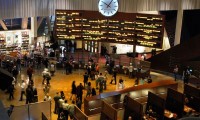Pending the arrival of this week’s finale, Mike Newell’s 2005 HARRY POTTER AND THE GOBLET OF FIRE may be, on balance, the most satisfying of the series. It combines first-rate moviemaking with one of J.K. Rowling’s most ingeniously constructed, emotionally rich stories–capped, of course, by the unveiling of Ralph Fiennes as the finally fully alive Lord Voldemort.
Newell isn’t the cinematic wizard that Alfonso Cuaron is, and visually Goblet of Fire is a bit of a step backwards from Prisoner of Azkaban. Newell, who started his career in the 1960s, had made such fine films as Donnie Brasco, Four Weddings and a Funeral and Dance With A Stranger, but he wasn’t exactly an epic adventure guy; when he tried the genre again after his Potter sojourn, the result was the sad Prince of Persia. Roger Pratt, who had photographed Chamber of Secrets, returned behind the camera for Goblet of Fire, making for a somewhat more stagier look and more old-fashioned lighting. In other respects, though, the picture certainly has more drive and snap than the Chris Columbus chapters, with sharp editing by Mick Audsley (who’s worked often with Stephen Frears) and score by Patrick Doyle.
Newell handles the action well enough (the dragons and mer-people are extremely convincing, and the living maze quite disturbing). He also compellingly guides viewers through the complications of the storyline–screenwriter Steve Kloves had his hands full with Goblet of Fire, which could easily have been expanded to 2 full-length films (it’s too bad so much of the Quidditch World Cup and the Hagrid/Madame Maxime romance had to be lost). It would have been easy to tangle the audience in the shifts between Twiwizard Cup action sequences, inter-student conflicts and the overriding Voldemort plot, but Newell and Kloves do a yeoman’s job of steering the tale forward.
Newell’s greatest strength is with the actors. The usual giant cast of British veterans inhabit Goblet, and they’re joined by Miranda Richardson (who had starred in Dance With A Stranger), delicious as Rita Skeeter; David Tennant, briefly but scarily vicious as Barty Crouch Jr; and especially Brendan Gleeson, so good as Mad-Eye Mooney that it’s too bad subsequent chapters didn’t give him more to do. (And of course there’s Robert Pattinson, whose on-screen death became an omen of how successful he’d become as one of the undead.) Goblet of Fire, though, is most notable as the movie that first showcased how polished its young stars had become. The Yule Ball storylines allow them (especially Rupert Grint) to show off their comic chops, and Newell gives Emma Watson a lovely little Audrey Hepburn moment as she walks down the stairs at the ball and everyone else in the cast realizes how beautiful she is. Later on, as the story takes its darker turns, Daniel Radcliffe faces down Ralph Fiennes–Amon Goeth of Schindler’s List in all his sneering villainy–and proves himself a worthy adversary.
Goblet of Fire returned the series to the boxoffice heights of the first two films, grossing $100M more worldwide than Prisoner of Azkaban had. Tonally, it was the film that turned the corner for the series, providing plenty of large-scale action sequences and humor, but also effectively laying the ground for the much darker, more demanding storylines that would soon follow.




